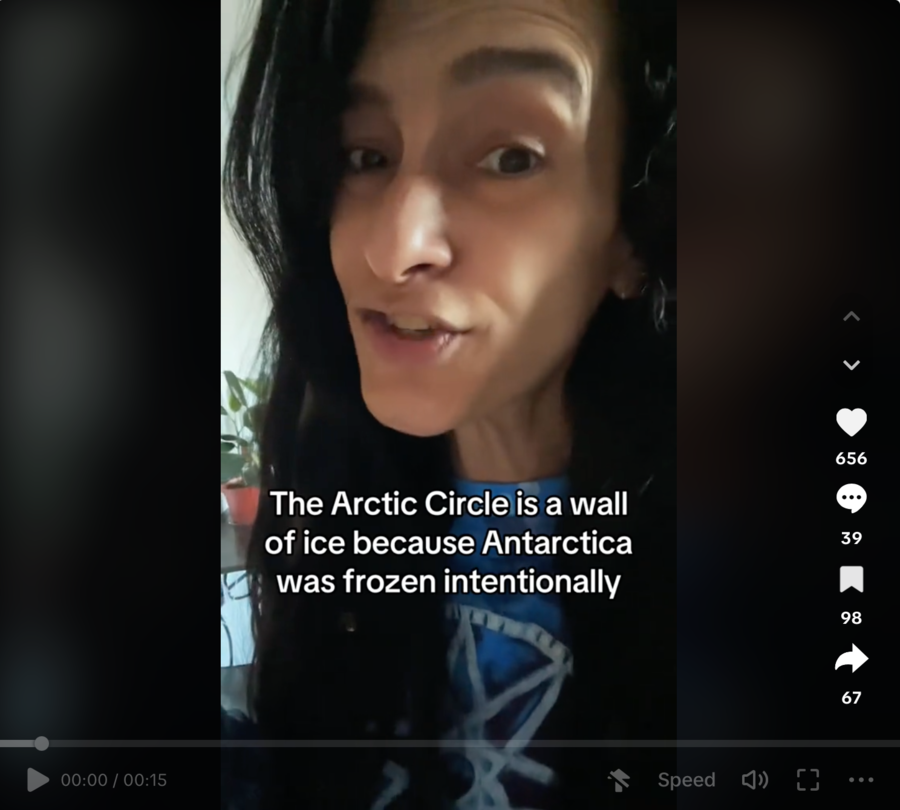
Did humans artificially create Antarctica's ice cap in order to boost energy emissions from frozen metals? No, that's not true: Scientists say Antarctica began freezing about 34 million years ago due to a drop in carbon dioxide in the atmosphere. That's about 28 million years before the earliest humans walked the Earth and about 34 million years before artificial refrigeration was invented.
The claim appeared in a video (archived here) on TikTok on September 3, 2024, with the caption "Frozen metals release energy." The 15-second video opens with a woman saying:
The Arctic Circle is a wall of ice because Antarctica was frozen intentionally. So, I have metals in my freezer because they release electricity and energy when frozen. That's why we froze Antarctica.
This is what the post looked like on TikTok at the time of writing:
(Source: TikTok screenshot taken on Wed Sep 4 15:11:15 2024 UTC)
It is not clear why the woman in the video says "the Arctic Circle is a wall of ice" and then discusses Antarctica. The Arctic Circle is on the other side of the planet from Antarctica and average summer temperatures there can rise well above freezing, according to the National Snow and Ice Data Center.
The mile-thick ice sheet that covers Antarctica began developing about 34 million years ago after carbon dioxide (CO₂) levels in the Earth's atmosphere dropped by about 40 percent, according to Matthew Huber, a professor of earth and atmospheric sciences at Purdue University. He was quoted in a 2011 interview published in the Science Daily publication (archived here) discussing a study he co-wrote on the origins of Antarctic ice (abstract archived here). Huber said:
The evidence falls in line with what we would expect if carbon dioxide is the main dial that governs global climate; if we crank it up or down there are dramatic changes ... We went from a warm world without ice to a cooler world with an ice sheet overnight, in geologic terms, because of fluctuations in carbon dioxide levels.
Carbon dioxide is a gas that absorbs heat and redistributes it across the Earth's surface; higher concentrations in the atmosphere keep temperatures warmer, according to the U.S. National Oceanic and Atmospheric Administration.
Huber's argument that a CO₂ drop was responsible for Antarctica's ice cap was also advanced by scientists in a 2009 letter to the Nature publication (archived here). Scientists have not determined what triggered the plunge in atmospheric carbon dioxide 34 million years ago, Science Daily said.
This data makes it unlikely that humans had anything to do with Antarctica's deep freeze. The earliest evidence of hominids -- that is, human ancestors who walked upright -- dates back 5 million to 6 million years, according to a 2003 study that appeared in the Journal of Experimental Biology (archived here).
Moreover, it took a few more million years before these hominids' descendants developed the technology that made artificial freezing possible. Scottish scientist William Cullen was the first to publicly demonstrate the refrigerative effects of evaporative cooling in 1756, according to Encyclopedia Britannica (archived here). It was not until 1834 that U.S. inventor Jacob Perkins secured a patent for a device that used a vapor-compression system for refrigeration, according to the American Society of Mechanical Engineers (archived here).
Other Lead Stories fact checks concerning Antarctica's ice cap can be found here.















